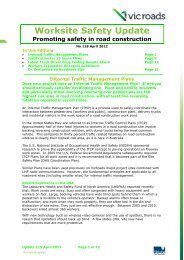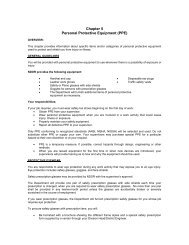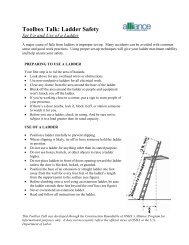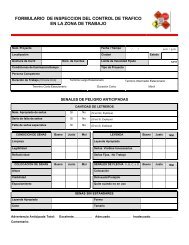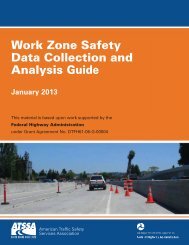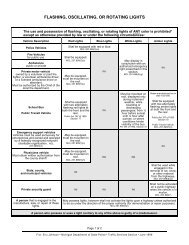California Joint Utility Traffic Control Manual - National Work Zone ...
California Joint Utility Traffic Control Manual - National Work Zone ...
California Joint Utility Traffic Control Manual - National Work Zone ...
Create successful ePaper yourself
Turn your PDF publications into a flip-book with our unique Google optimized e-Paper software.
<strong>California</strong> <strong>Joint</strong> <strong>Utility</strong> <strong>Traffic</strong> <strong>Control</strong> <strong>Manual</strong><br />
transition. For nighttime work, lighting the work zone and approaches will allow<br />
the motorist better comprehension of imposed requirements. Since traffic<br />
patterns change, observation should be conducted periodically and adjustments<br />
made accordingly to assure traffic flow.<br />
Each person whose actions affect the TTC zone safety, from upper-management<br />
through the field worker, should receive training appropriate to the job decisions each<br />
individual is required to make. Only those individuals who are trained in proper TTC<br />
practices and have a basic understanding of the principles (established by applicable<br />
standards and guidelines) should supervise the selection, placement and maintenance<br />
of TTC devices for TTC zones and for incident management.<br />
NOTE: Before any new detour or temporary route is opened to traffic, all<br />
necessary signs shall be in place. All TTC devices shall be removed as soon as<br />
practical when they are no longer needed. When work is suspended for short<br />
periods of time, TTC devices that are no longer appropriate shall be removed or<br />
covered.<br />
Good public relations should be maintained by applying the following:<br />
1. The needs of the road user should be assessed such that appropriate advance road<br />
notice is given and clearly defined alternative paths are provided.<br />
2. The cooperation of the various news media should be sought in publicizing the<br />
existence and reason for the TTC zones as news releases can assist by keeping the<br />
road user well informed.<br />
3. The needs of abutting property owners, residents, and businesses should be<br />
assessed and appropriate accommodations made.<br />
4. The needs of emergency service providers (law enforcement, fire, and medical)<br />
should be assessed and appropriate coordination and accommodations made.<br />
5. The needs of railroads and transit should be assessed and appropriate coordination<br />
and accommodations made.<br />
6. The needs of operators of commercial vehicles such as busses and large trucks<br />
should be assessed and appropriate coordination and accommodations made.<br />
Temporary <strong>Traffic</strong> <strong>Control</strong> (TTC) General/Reference Information<br />
Short Duration <strong>Work</strong> Operations<br />
The CA MUTCD addresses work duration under section 6G.02 <strong>Work</strong> Duration and<br />
states:<br />
<strong>Work</strong> duration is a major factor in determining the number and types of devices<br />
used in TTC zones. The duration of a TTC zone is defined relative to the length<br />
of time a work operation occupies a spot location.<br />
Standard:<br />
The five categories of work duration and their time at a location shall be:<br />
A. Long-term stationary is work that occupies a location more than 3 days.<br />
B. Intermediate-term stationary is work that occupies a location more than one<br />
daylight period up to 3 days, or nighttime work lasting more than 1 hour.<br />
12



